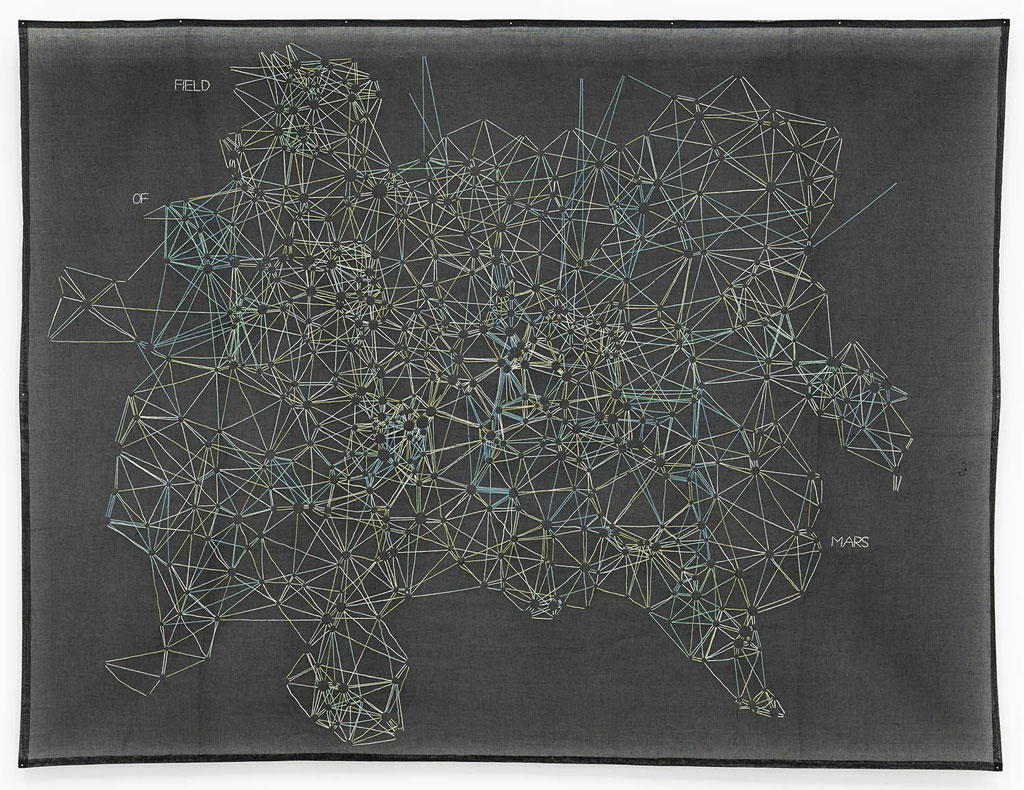ART-PRESENTATION: Jessica Rankin-There and Not There
 Appropriating methods traditionally identified with feminine pursuits (embroidery and needlework) Jessica Rankin’s work features a series of “mental maps”, with codes, signs and symbols that explore ideas of memory, intuition and interpretation. Rankin’s embroidered paintings begin with colored panels of organdy, a fabric known for its sheer, diaphanous quality. Into this material the artist stitches renderings of mountain terrains, thermodynamic charts and astronomical maps, all of which mutate into lines of text before collapsing back into landscape drawing. The text assumes an abstract quality, executed in capital letters that call to mind the embroidered works of Alighiero Boetti. Taking the form of random thought patterns, these strings of words slip into phrases that avoid narrative structure from one to the other.
Appropriating methods traditionally identified with feminine pursuits (embroidery and needlework) Jessica Rankin’s work features a series of “mental maps”, with codes, signs and symbols that explore ideas of memory, intuition and interpretation. Rankin’s embroidered paintings begin with colored panels of organdy, a fabric known for its sheer, diaphanous quality. Into this material the artist stitches renderings of mountain terrains, thermodynamic charts and astronomical maps, all of which mutate into lines of text before collapsing back into landscape drawing. The text assumes an abstract quality, executed in capital letters that call to mind the embroidered works of Alighiero Boetti. Taking the form of random thought patterns, these strings of words slip into phrases that avoid narrative structure from one to the other.
By Dimitris Lempesis
Photo: Carlier|Gebauer Archive
The works in Jessica Rankin’s solo exhibition “There and Not There” mark a radical shift in the artist’s materials and approach. While earlier works were primarily rendered in silvery and lavender monotones, and embroidery thread was used to create slippages between landscape and text, the new works delve much more deeply into the language of painting. Rankin has described their making as a state of “free fall”. Emerging from an intuitive and unmediated process, these exuberant works are marked by vibrant floating color fields. Rankin uses an expanded range of materials to paint with in this series. What first appears as an amorphous patch of color reveals itself as embroidery floss upon closer inspection. A dynamic interplay of materials ensues, in which embroidery often continues, complicates, or interrupts the painted gesture—at times even imitating the quality and thickness of a brush-stroke. Similarly, in works like “Thread Suns” undulating swathes of fabric extend the composition of the painting into three dimensions. Indeed, there is something emphatically object-like about many of these works, particularly in how they incorporate language. Fragments of Rankin’s own writing, as well as the work of other poets and Babylonian creation myths, line the sides of the canvas. Most of the paintings spill over onto the sides of their stretchers, which are the most heavily worked parts of the painting—seamlessly continuing the color of the painted surface in embroidery floss. Rankin’s layered veils of color at times recall the “abstract climates” of Helen Frankenthaler, yet the joyousness that her paintings exude nonetheless emerge within a particularly dark socio-political context in the United States where the artist is based. Within this climate, a stance of intimacy and tenderness is both an act and space of resistance. The title for the exhibition is inspired by the Romanian poet Paul Celan. A Holocaust survivor who continued to write in his native German, Celan’s abstract, highly idiosyncratic style pushed the limits of language: breaking open words, shattering grammatical syntax, and often writing his poems with very few words. Rankin’s latest body of work emerges from a comparable impulse. Both “there” and “not” there, it thrives in interstitial spaces: between media, between spaces, being in thrall to one’s own time, while simultaneously creating other means of living, creating, seeing, and doing.
Info: Carlier|Gebauer Gallery, Markgrafenstraße 67, Berlin, Duration: 16/3-18/4/19, Days & Hours: Tue-Sat 11:00-18:00, www.carliergebauer.com











